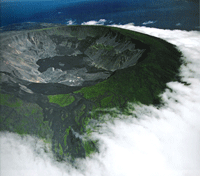|
Weather |
![]()
There are two seasons in the islands: garua and hot Between the months of June and November, when the Southeast Trade winds are stronger, the South Equatorial Current and the Cromwell Undercurrent predominate. The air and the sea are cooler. Often, a fine drizzle falls; this is the garua, which gives its name to the season. From December to May, the Northeast Trade winds blow and the hot Panama Current prevails. The heat increases and rainfall is abundant. The winds and the ocean determine life in Galapagos. The archipelago has a varying climate, marked by a scarcity of rain. The majority of the islands are arid, though there is lush vegetation growing in the highlands of the larger islands. Galapagos lies at the meeting place of winds and ocean currents coming from the north and the south. These determine the climate of Galapagos and the distribution and abundance of its species. Dry Season (windy-dry): June to November ave. 22 Degrees Celsius Water Temp. Dry Season:Average surface water temperature in June is 23.3°C ( 74°F ), while in November is 22.8°C ( 73°F ). Peak month is September with 21.6°C (70°F) . Visibility of the water ranges from 15 to 50 feet. In unusually dry years (like La Niña years) waters can even reach 16°C (61°F). Snorkeling conditions: Since the water temperature reaches the "untrue" tropical range, one can expect generally waters with some current, and a slight decrease in visibility due to the amount of plankton particles suspended in the water column. This is the snorkeling season where a wet suit is likely to provide a higher comfort in the water. Note that wet suits are available for rent on some vessels.
Hot Season (warm-rainy) : December to May av. 25 Degrees Celsius Water Temp. Wet Season:Average surface water temperature in December is 23.2°C ( 74°F ), while in May is 24.5°C ( 76°F ). Peak month is March with 25.5°C (78°F). Visibility of the water ranges from 30 to 80 feet. In unusually warm years (like El Niño years) waters can even reach 29°C (84°F). Snorkeling conditions: since the water temperature reaches the "true" tropical range, one can expect generally calm waters, virtually non strong currents, and high chances of visibility.
What is the El Niño phenomenon and what consequences does it have in Galapagos? El Niño is an atmospheric phenomenon that alters the circulation of the water masses surrounding Galapagos. It occurs in certain years when the warm waters of the Panama Current extend further south and for a longer time than usual,causing a rise in sea temperature.Its effects are felt principally around Christmas and thus its name, “El Niño,” which means “child” refers to the Christ child. With the arrival of El Niño in Galapagos, rainfall increases, the sea temperature rises, and the abundance of certain marine species diminishes drastically. Populations of seabirds, fur seals, and marine iguanas diminish due to lack of food, while some fish and marine invertebrates proliferate. With continued rain, however, problems begin for the land organisms, too. Cactus become top-heavy with the increased growth and topple over. With the soil saturated with moisture, many Scalesia trees die. |
||
 |
 |
 |
